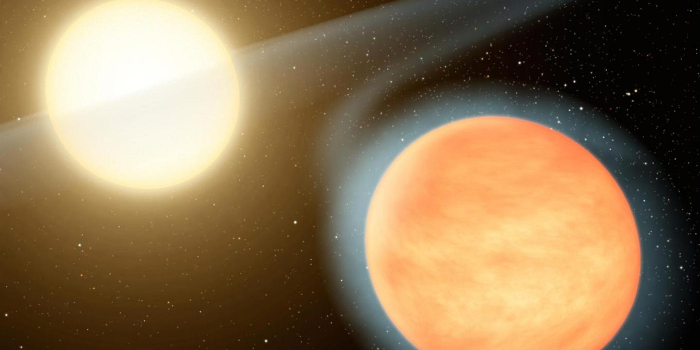WASP-12b, a planet around 14 hundred light years away from our Earth, is about to die. It has already started its dance of death, ending with the planet smashing into its parent star. WASP 12b is twice the size of Jupiter. Previously, it was thought the Earth had around 1o million years before its inevitable crash into its parent star. However, researchers believe it may happen relatively quicker in astronomical terms,
“According to our calculations, the planet will crash into the star [WASP-12] in just 3 million years, a concise amount of time considering the star only appears to be 3 billion years old,” Pietro Leonardi, research lead author and University of Padova scientist told Space.com.
WASP 12b rotates around its parent star so close that a year on the scorching hot planet can fit into one Earth day. Its close proximity to the parent star is why its surface temperature soars to 4,000 degrees Fahrenheit (2,210 degrees Celsius).
Apart from the fact that it’s super-hot, it has an exceptional gravitational pull. Being so close to its star generates considerable tidal energy, resulting in the planet being egg-shaped. There is also a disk of matter around the yellow planet, which consists of all matter stripped of the WASP 12b due to the immense gravitational field.
Other than being one of the hottest planets out there with an unimaginable gravitational pull, there is more to this planet. It also orbits its star at different time frames. The Asiago Observatory in Italy collected these observations over a period of 12 years between 2010 and 2022.

Another thing that the team observed was related to the star WASP 12. They concluded that the star had already come to the end of its main-sequence lifetime, after which stars burn hydrogen in their cores.
“According to the tidal theory, the dissipation we see in the system is too strong to be explained by a main sequence star. If the star had already left the main sequence and entered its sub-giant phase, this could be easily explained,” Leonardi said. “To test this theory, we used high-resolution optical spectra from the High Accuracy Radial Velocity Planet Searcher in the Northern Hemisphere (HARPS-N) to derive the stellar parameters of the star and infer its evolutionary stage. However, according to our results, the star is still in the main sequence and has not yet entered its sub-giant stage.”
This implies that the team still needs some explanation of how rapid tidal dissipation can be caused by a main sequence dwarf star. In approximately three million years, WASP 12b will plunge into its parent stars, and the resulting phenomena will be visible from Earth.
“When the planet inevitably crashes into the star, the first indication will be an outburst of luminosity, which will see the star become hundreds of times brighter than it is today,” Leonardi said. “This increase will not last long and will quickly fade away. But maybe the future humans could be there to see and study it.”
This study also indicates that other ultra-hot stars may be on a collision course with their own stars.

“We still have to figure out if what we observed is a unique scenario or a common event in the universe,” Leonardi said. “According to some population studies, the number of hot Jupiters orbiting very close to their stars decreases when we observe older stars, so this could indicate that many planets experience tidal decay and crash into their stars.”
Leonardi added that he is now working with the team behind the European Space Agency (ESA) mission CHaracterising Exoplanet Satellite (CHEOPS) to determine the orbital decay rate of other hot Jupiters.
“This study is just the beginning of a long search for orbital decay,” he concluded.


